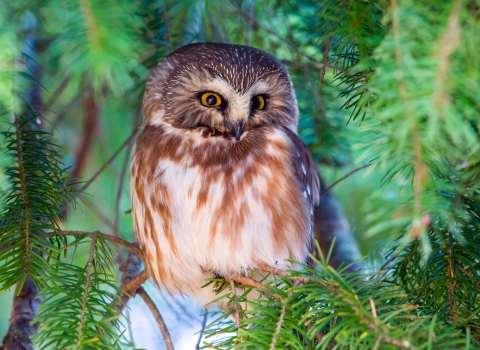Smitten with sloths, an adoring international public may not realize the species they most often see has a diminutive relative living on a tiny island north of Panama’s mainland, the only place the pygmy three-toed sloth is known to exist on Earth. This small sloth – a resident of red mangroves and other plants on Isla Escudo de Veraguas -- shares the serene expression, unhurried movements, and many of the same threats to its existence as its larger relatives, which is why the U.S. Fish and Wildlife Service is proposing to list it as threatened under the Endangered Species Act with a special rule allowing exceptions for certain otherwise prohibited activities.
Weighing in at 6-plus pounds and sporting a black and white face on a tan body, the pygmy sloth is most closely related to the brown-throated three-toed sloth, its more visible mainland relative. Although it was described as a full species in 2001, little is known about the pygmy sloth’s life history and habitat requirements. Pygmy sloths are known to eat red mangroves and 14 other plant species on Escudo.
The primary threats to the pygmy sloth are increased development and tourism. Although there is minimal to no current trade of the pygmy sloth, the species is listed under the Convention on International Trade in Endangered Species of Wild Fauna and Flora Appendix II. Adding an ESA violation on top of a CITES violation could act as an additional disincentive for any illegal trade of the species.
Other threats to the pygmy sloth include the small size of Escudo and the species’ population and direct and indirect impacts of tourism, habitat loss from small-scale timber harvest, and habitat loss from sea level rise and erosion. These threats make the sloth vulnerable to random environmental catastrophes, such as storms. The pygmy sloth is currently considered resilient, but tourism and development are expected to increase on and around Escudo.
The Pygmy Sloth Conservation Project uses innovative and integrative activities to support pygmy sloth and Escudo conservation. The project includes repeated population surveys, education of Indigenous communities and schoolchildren regarding Escudo ecology and the benefits of conservation, and cooperation with the Indigenous government and local fishermen’s association to develop a community-based natural resources management program. But while Escudo is designated as a protected area, enforcement and regulatory capacity to the island are inadequate due to limited resources and the remoteness of the area.
You can make a difference in the pygmy sloth’s future by providing information and comments on the Service’s proposal to list the species under the Endangered Species Act. Please visit https://www.federalregister.gov/documents/2024/03/26/2024-05724/endangered-and-threatened-wildlife-and-plants-threatened-species-status-with-section-4d-rule-for for more information.





